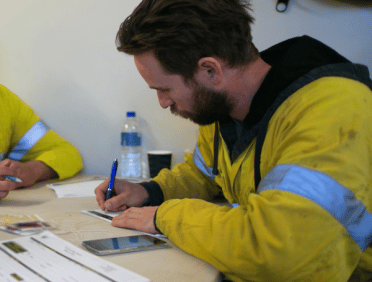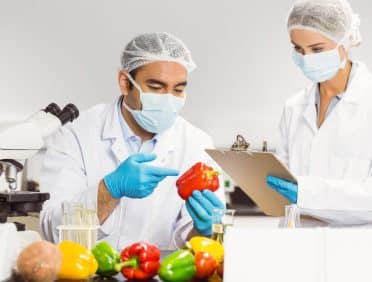In our day-to-day lives, we all have a vested interest in food safety and instinctively avoid consuming anything that could jeopardise our health.
But who determines what is safe to eat and what is not? The answer lies in the risk assessment procedures that evaluate potential hazards. This involves identifying and characterising potential risks associated with a particular food or ingredient, assessing exposure levels, and ultimately determining whether action is necessary to prevent harm to consumers.
Understanding risk assessment processes is crucial for ensuring the safety of our food supply, the happiness of your customers, and ultimately the health of your business.
What are food safety risk assessments?
Food safety risk assessments are systematic evaluations of potential hazards associated with food products or ingredients. These assessments aim to identify and analyse the potential risks to human health posed by various factors, such as the presence of harmful bacteria, chemical contaminants, or other substances that may cause harm.
The process of risk assessment involves several steps, including hazard identification, hazard characterisation, exposure assessment, and risk characterisation:
- Hazard identification involves identifying and describing potential hazards associated with a particular food or ingredient,
- Hazard characterisation involves determining the nature and severity of the hazard.
- Exposure assessment involves estimating the amount of the hazardous substance that consumers are likely to be exposed to, and
- Risk characterisation involves combining the information from the previous steps to estimate the likelihood and severity of harm to the health of your customers.
Ultimately, the information gathered through these risk assessments is used to inform decisions about the safety of food products and ingredients, and to determine whether any action, regulatory or otherwise, is necessary to protect public health.
What are the risks in the food industry?
- The food industry is faced with various risks that can affect the safety, quality, and availability of food. Some of the risks in the food industry include:
- Foodborne illness: Contamination of food with harmful bacteria, viruses, parasites, or chemical contaminants can cause foodborne illnesses that can range from mild to severe, and even life-threatening.
- Allergens: Food allergens such as peanuts, tree nuts, milk, eggs, wheat, soy and others can cause severe allergic reactions in some individuals.
- Chemical contamination: Food can be contaminated with chemical substances such as pesticides, heavy metals, and environmental contaminants that can pose health risks to anyone who consumes the food.
- Food fraud: Intentional misrepresentation of food products for financial gain, such as mislabeling or adulteration, can pose risks to consumer health and safety.
- Supply chain disruptions: Disruptions in the food supply chain, such as natural disasters, disease outbreaks, or transportation issues, can impact the availability and safety of food.
- Quality issues: Poor quality control, improper storage, or improper handling can lead to spoilage, reduced shelf life, and decreased nutritional value of food.
- Ethical concerns: Unfair labor practices, animal welfare concerns, and environmental impacts of food production can affect the ethical and social responsibility of the food industry.
Addressing these risks and ensuring the safety, quality, and availability of food is critical for protecting public health and maintaining consumer confidence in the food industry.
Risk Assessment and its Role in Risk Analysis
To limit the risks of the food we provide, risk assessment should be carried out. Risk assessment is a critical component of the risk analysis process, and is a systematic approach used to identify, evaluate, and manage risks associated with a particular activity, process, or product.
Risk assessment is the first step in the risk analysis process and involves the evaluation of potential hazards and risks associated with a particular activity, process, or product. It involves identifying any hazards, assessing their likelihood and severity, and determining the potential impact of those hazards on human health or the environment.
The role of risk assessment in risk analysis is to provide a basis for identifying, evaluating, and managing risks. It helps to identify potential hazards and their associated risks, and provides a basis for prioritising actions to reduce or mitigate those risks.
Risk assessment can also be used to help inform the most effective risk management strategies, such as implementing control measures to reduce the likelihood or severity of hazards or implementing monitoring programs to detect potential hazards swiftly and on an ongoing basis.
You can download our FREE risk assessment template by clicking here.
The difference between hazard and risk
Hazard and risk are two related but distinct concepts in the field of risk assessment and management, which any food handler needs to be aware of.
A hazard is any source of potential harm or adverse health effect. Hazards can include physical hazards, such as sharp objects or extreme temperatures, chemical hazards, such as toxic substances or allergens, biological hazards, such as infectious agents or harmful microorganisms, and other hazards, such as radiation or noise.
Risk, on the other hand, is the likelihood or probability that a hazard will result in harm or adverse health effects. Risk is determined by considering the exposure to the hazard and the vulnerability or susceptibility of individuals to the hazard.
In other words, a hazard is a potential source of harm or danger, while risk is the chance or likelihood that the hazard will cause harm or danger. For example, a sharp knife is a hazard, but the risk of harm from the knife depends on factors such as how the knife is being used, who is using it, how often it is being used, and what safety measures are in place.
Understanding the difference between hazards and risks is important for effective risk management. In risk management you will need to identify any hazards that are likely to occur in your business and evaluate them to determine the potential risks to your colleagues, customers and the environment associated with them. The information from your risk assessment is then used to prioritise actions to reduce or mitigate those risks, therefore offering protection from them.
Food safety risk analysis
Food safety risk analysis is a process you can use to assess, manage and communicate the risks associated with food safety.
The process of food safety risk analysis typically involves three main steps: risk assessment, risk management, and risk communication.
- Risk assessment: As mentioned, the first step in the process is risk assessment. This involves identifying and evaluating potential hazards in your business, assessing the likelihood and severity of harm, and estimating the level of risk associated with each hazard.
- Risk management: Once you have identified and evaluated the potential hazards and risks, you can develop risk management strategies to reduce or mitigate those risks. This may involve introducing control measures to prevent or reduce the likelihood of hazards, such as food safety regulations, guidelines, and standards, or implementing monitoring programs.
- Risk communication: The final step in the process of food safety risk analysis is communicating the risk. Depending on the nature and size of your business, you need to think about what to communicate to customers, colleagues, and other stakeholders (such as partners). Effective risk communication is important for ensuring that people have access to accurate and timely information about the safety of the food they consume.
Risk assessment and managing risks
Risk assessment and managing risks are closely related.
As mentioned, risk assessment is identifying and evaluating hazards and risks, while risk management is what happens after the risks have been evaluated to control or minimise them.
The ultimate goal of risk management is to reduce or eliminate the potential for harm or adverse effects associated with the risks you have identified, so that they do not have a negative impact on your business or those involved in it.
Identify hazards
- Identifying hazards is a critical step in the risk assessment process. Some examples of food related hazards that you may identify during a risk assessment are:
- Biological hazards: bacterial pathogens such as Salmonella, Listeria, and E. coli, which can cause foodborne illnesses.
- Chemical hazards: can include cleaning chemicals, pesticides, and other toxic substances that can contaminate food products
- Physical hazards: objects such as broken glass, metal fragments, or other foreign materials that may accidentally contaminate food products during processing, packaging, or transportation. Physical hazards may also be food preparation machinery, sharp knives and sharp edges that may be a danger to colleagues and customers.
- Allergens: Food allergens such as fish, shellfish, sesame, wheat or mustard can cause severe allergic reactions in some individuals so they need to be identified and labelled.
- Environmental hazards: can include factors such as air pollution, water pollution, and climate change.
- Ethical concerns: such as animal welfare issues, unfair labour practices, and sustainability concerns.
- Food fraud: Food fraud can include intentional misrepresentation of food products such as mislabeling, adulteration, or counterfeiting. It’s always good to know exactly how trustworthy your sources are.
Once you have identified the hazards you would then assess the risks.
Assess the risks
As above, assessing food safety risks is best done through a step by step process. A typical approach might be:
First, determine the likelihood and severity of harm that could result from exposure to each of the hazards you have identified. Consider factors such as the amount or concentration, how someone could become exposed, and how susceptible people are to that hazard.
Next, evaluate the level of exposure that those who will be impacted by your business. This might include the frequency and amount of consumption, as well as the potential for cross-contamination during processing, packaging, or transportation.
Now, combine the information from the previous steps to estimate the level of risk associated with each of the hazards identified. This may involve using quantitative or qualitative methods to estimate risk.
Next, implement the risk management strategies you have planned that can reduce or mitigate the risks identified. See the next section for some ideas.
Finally, continuously monitor and review the effectiveness of your risk management strategies over time, making adjustments where necessary.
Control the risks
When you start to manage risks, it is important to control them on an ongoing basis using your risk management strategies, These strategies might include:
- Implementing good hygiene practices: throughout the food supply chain, including proper hand washing, cleaning and sanitising equipment and facilities, and maintaining proper temperature control during processing, storage, and transportation.
- Implementing control measures: such as implementing food safety regulations that are relevant to your business, applying guidelines, and standards, and continuous monitoring.
- Using hazard analysis and critical control points (HACCP) to identify and control hazards from raw materials to finished products. If you are unfamiliar with HACCP, it is worth studying a course such as the one provided by Learn Q.
- Providing training to colleagues on food safety practices and procedures, to ensure that they are aware of the hazards in your business and know how to implement the control measures you have introduced. If you have new starters, you can take advantage of our money saving course bundles such as the Food Hygiene Level 2 bundle.
- Implementing traceability systems to track and recall products if a potential hazard is identified.
- Communicating with customers about potential food safety risks and providing information on how to safely handle, prepare, and store food products to colleagues. If you haven’t already, you can use some of the free downloadable posters on our blog page which can be displayed in your workplace.
- And of course, monitor and review the effectiveness of your risk management strategies over time.
Record your findings
- Accurately documenting the findings of a risk assessment is crucial, even though businesses with less than five employees aren’t legally required to do so. Keeping records allows you to review the assessment later, especially if there are any changes in the workplace.
- Using a risk assessment template is a straightforward method of recording your findings, including your health and safety policy, in one location. When recording your results, keep it simple, for instance:
- Tripping over rubbish: Bins provided, staff trained, weekly housekeeping checks.
- Storage of knives: Labelled storage areas provided, staff trained, checks scheduled.
- The risk assessment does not have to be perfect, but it must be ‘suitable and sufficient’. You can get an idea of what your risk assessment should look like by checking the example risk assessments on the Health and Safety Executive website.
Your records should show that you:
-
- Conducted a thorough check
- Considered all potentially affected parties
- Addressed significant hazards
- Ensured precautions are reasonable, and risk is low
- Involved staff or their representatives in the process.
Review the controls
Reviewing food safety controls is an essential part of ensuring the effectiveness of your risk management strategies. Some steps to review food safety controls can be:
- Define the criteria that you will use to evaluate the effectiveness of your food safety controls. These could include identifying your compliance with regulatory requirements, measuring your effectiveness in preventing or reducing hazards, and your ability to meet industry standards.
- Collect data on the performance of your food safety controls. To do so will mean identifying ways of measuring their effectiveness.
- Analyze the data collected to determine whether the food safety controls you have implemented are effective in preventing or reducing potential hazards, and identify any areas that may require improvement.
- Conduct regular audits of your food safety controls to ensure they are compliant with regulatory requirements and industry standards, identifying any areas for improvement.
- Engage stakeholders, including colleagues, customers, and suppliers, in the review process to ensure that their perspectives are considered in the evaluation of your food safety controls.
- Implement any necessary improvements to your food safety controls based on your review findings. You may need to revise your policies and procedures, provide additional training to colleagues, or invest in new technologies or equipment.
- Continue to monitor and evaluate the effectiveness of the improvements over time, and make adjustments as necessary to ensure continued effectiveness. It is worth diarising specific time for monitoring activities so that nothing gets missed.
Types of hazards in food safety
The three main types of hazards in food safety are:
- Biological hazards including bacteria, viruses, parasites, and other microorganisms.
- Chemical hazards include substances that can cause harm through exposure or ingestion.
- Physical hazards include objects that may accidentally contaminate food products like bone fragments, plastic, or rocks.
Allergens
Food allergens are substances that can cause an allergic reaction in some individuals when consumed. The immune system of individuals with food allergies mistakenly identifies certain food proteins as harmful, triggering an allergic response that can range from mild to severe, and in some cases, life-threatening.
It’s important for businesses to be aware of the nature of allergens and make these clear to customers, while also taking measures to prevent cross-contamination of allergens in the processes that you use.
You can download our free allergen poster here.
Chemical hazards
Chemical hazards can come from a variety of sources, including pesticides, industrial chemicals, environmental contaminants, and food additives.
Here are some examples of chemical hazards:
- Pesticides that are commonly used in agriculture to protect crops from pests, and can contaminate food products
- Industrial chemicals, that might be present in your own cleaning products or those of your suppliers
- Food additives which may be added by yourselves or your suppliers and can cause adverse reactions in sensitive individuals or when consumed in large amounts.
- Heavy metals, such as lead, cadmium, and mercury which may be present in packaging or equipment and can cause serious health problems, including neurological damage and developmental delays.
Chemical hazards can largely be managed through your risk management strategies, as explained above.
Microbiological hazards
Microbiological hazards caused by microorganisms such as bacteria, viruses, and parasites, which can cause illness if consumed. Some of the most common are:
- Salmonella: bacteria commonly found in poultry, eggs, and other animal products. It can cause symptoms such as diarrhea, fever, and abdominal cramps.
- Listeria: bacteria that can contaminate products including dairy, meats, and produce. It can cause symptoms such as fever and muscle aches, and can be particularly dangerous for pregnant women, the elderly, and individuals with weakened immune systems.
- E. coli: bacteria commonly found in ground beef and other animal products. It can cause symptoms such as diarrhea, abdominal cramps, and vomiting.
- Norovirus: a virus that can contaminate food products such as shellfish and ready-to-eat foods. It can cause symptoms such as vomiting and diarrhea.
Preventing microbiological hazards can be managed using good hygiene practices, HACCP, and other control measures.
Physical hazards
Physical hazards refers to any foreign objects that may accidentally contaminate food products at any stage of the process.
- Some examples are:
- Bones: a physical hazard in foods such as meat or fish products. Small bones can be difficult to detect and can cause choking or injury if ingested.
- Stones: or pebbles can be present in some produce, such as beans or lentils, and can cause injury if consumed.
- Metal fragments: can enter food products during processing, packaging, or transportation and can also cause injury if consumed.
- Glass: can break during processing, packaging, or transportation, accidentally contaminating food products.
Physical hazards can be prevented through strategies such as proper cleaning and sanitation of equipment and facilities, and inspection of raw materials and finished products to detect and remove foreign objects.
Principles for Risk Assessment of Chemicals in Food
The principles for risk assessment of chemicals should follow the principles below:
Hazard identification
This involves identifying and characterizing potential hazards that may pose a risk to human health or the environment. You can identify hazards using the process below:
- Conduct a thorough review of relevant scientific literature, regulatory guidelines, and industry standards to identify potential hazards associated with the food product or process being evaluated.
- Gather data on the food products or processes being evaluated, including information on ingredients, raw materials, processing steps, and potential sources of contamination.
- Conduct a hazard analysis to identify potential hazards, taking into account factors such as biological, chemical, physical, or allergenic hazards, and assess the severity and likelihood of each potential hazard.
Hazard characterization and Exposure assessment
The key steps involved in characterizing food safety hazards are:
- Assess toxicity: Evaluate the toxicity of the potential hazard by reviewing available data on its chemical or biological properties, and determining its potential health effects.
- Evaluate exposure pathways: Determine how the hazard may enter the food supply and the potential pathways of exposure, such as ingestion, inhalation, or skin contact.
- Assess exposure levels: Evaluate the level of exposure to the hazard by estimating the amount of the hazard that may be present in the food product, and the amount that may be consumed by the population.
- Consider vulnerable population groups: Identify population groups that may be more vulnerable to the health effects of the hazard, such as infants, pregnant women, or individuals with compromised immune systems.
- Determine the severity of health effects: Assess the potential health effects of the hazard by considering the severity of the effects and the likelihood of occurrence.
- Establish safe levels of exposure: Determine the safe levels of exposure to the hazard by establishing acceptable daily intake levels, reference doses, or other criteria based on available scientific data.
- Determine the level of risk: Combine the information from the previous steps to assess the overall level of risk associated with exposure to the hazard.
Risk characterization
The process for characterizing risk is almost identical to those involved in assessing hazards, as described above.
Effective risk management
Effective risk management in food safety involves a systematic approach to identifying, assessing, and mitigating potential hazards in the food industry. The most effective way to manage risk is by following the strategies outlined in this blog, including the key steps of:
- Hazard identification
- Risk assessment
- Risk communication
- Risk mitigation and
- Continuous improvement
Risk assessment in the food safety plan
It is recommended that you incorporate your risk assessment into a food safety plan to ensure the safety and quality of the food supply.
A food safety plan is a systematic approach to identifying and mitigating potential hazards in the food industry, with the purpose to prevent, reduce, or eliminate the risks associated with exposure to biological, chemical, physical, or allergenic hazards, and to ensure that food products are safe for consumption.
A food safety plan typically includes your:
- Hazard analysis
- Preventive controls
- Monitoring procedures
- Corrective actions
- Verification procedures
- Recordkeeping procedures
How to increase workplace health and safety
Utilising the information in this blog, you can improve the health and safety in your workplace. The top ways to further improve your workplace health and safety are:
- Conduct a hazard assessment: Identify potential hazards in the workplace, and develop strategies to eliminate or minimize them.
- Provide training: Train colleagues on the safe use of equipment, proper handling of hazardous materials, and procedures for responding to emergencies.
- Establish safety protocols: Develop and implement safety protocols, such as Standard Operating Procedures (SOPs), Hazard Analysis and Critical Control Points (HACCP), or lockout/tagout procedures.
- Encourage communication: Encourage colleagues to report any safety concerns or hazards they encounter in the workplace, and establish open channels of communication to address these issues.
- Promote ergonomics: Provide ergonomic workstations and equipment, and encourage colleagues to take breaks and stretch regularly to prevent injuries.
- Ensure proper ventilation: Ensure proper ventilation and air quality in the workplace to prevent exposure to harmful chemicals or pollutants.
- Provide personal protective equipment (PPE): Provide appropriate PPE, such as gloves, safety glasses, or respirators, to protect colleagues from potential hazards.
- Conduct regular inspections: Conduct regular inspections and audits to ensure that workplace health and safety protocols are being followed, and make necessary changes or improvements.
Food Safety Online Training
If you haven’t already got it, one way to start training yourself and your colleagues is to take a Food Hygiene course.
- Level 2 Food Safety Training: is an introductory course that covers basic food safety principles and practices. This qualification is designed for anyone who works with food, including front-line staff and supervisors. The course typically covers topics such as food hygiene, food contamination, food storage and preservation, and personal hygiene.
- Level 3 Food Safety Training: is an advanced course that provides a more detailed understanding of food safety principles and practices. This qualification is designed for managers and supervisors who have responsibility for food safety in their workplace. The course typically covers topics such as food safety legislation, HACCP principles, risk assessment, and management of food safety hazards.
Level 2 training is more basic and suitable for front-line staff, while Level 3 training is more advanced and suitable for managers and supervisors with greater responsibility for food safety in their workplace.
All of our courses have discounts for 10+ orders
Or SAVE OVER 50% and ensure your business is even safer by choosing one of our bundles:













